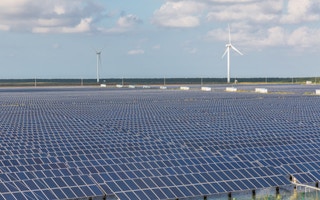Slowing economic growth and shrinking energy consumption mean that meeting the government’s ambitious goal for renewable energy consumption will remain a tough challenge as China’s energy sector embarks on a restructuring program in the coming five years.
Top leaders gathered in Beijing this week at a session of the Communist Party of China Central Committee to formulate proposals for the 13th Five-Year Plan (2016-20). Energy strategy will come under intense scrutiny because of the sector’s close connections with the economy and the environment.
China has pledged to increase the share of non-fossil fuels in the primary energy mix to 15 per cent by 2020, and to 20 per cent by 2030.
Experts say the program for the next five years is very clear; the general thrusts will be controlling coal consumption, stabilizing the use of oil and gas, increasing the use of wind and solar power, and speeding up energy-pricing reform to support the structural transition.
A target has been set to limit energy use to the equivalent of the annual use of 4.8 billion metric tonnes of standard coal by 2020, the State Council said in November.
Taking slower economic growth and weaker energy demand into account, the target is not as daunting as when it was set, according to Lin Boqiang, director of the China Center for Energy Economics Research at Xiamen University in Fujian province.
Theoretically, the government could impose restrictions, particularly on the use of coal, to press ahead with the transformation of the economic model, but that would be a difficult strategy to accomplish.
“Coal remains a competitive and convenient choice in practice, particularly at a time when the industry is facing excess capacity,” Lin said.
Energy use surged 45 per cent in the seven years running up to 2013, as a result of the country’s rapid economic growth. That significantly affected global energy demand, because China accounted for 23 per cent of the world’s total energy use.
Major coal consumers-industries such as power, steel, chemicals and building materials-are facing overcapacity and more stringent environmental standards, factors that are dragging down coal consumption.
Although last year saw the first decline in China’s coal output after 15 years of consecutive growth, coal still accounted for 66 per cent of the country’s energy consumption.
Both wind and solar power have enjoyed rapid expansion in recent years. According to a recent medium-term report on renewable energy from the International Energy Agency, China accounts for 40 per cent of global renewable capacity growth.
Obstacles remain Shi Lishan, deputy director-general of the New and Renewable Energy Department of the National Energy Administration, said the cost of solar power generation must be lowered, and many other technical and systemic obstacles need to be overcome to promote the growth of clean energies.
A large proportion of the electricity generated by wind and solar power goes unused as a result of insufficient transmission capacity.
In November, the State Council said China plans to install as much as 58 gigawatts of nuclear power by 2020. “Most of the additional capacity and new plants will be put into operation after 2020, so nuclear power is very likely to be emphasized in the new (five-year) plan, but that will mainly have an impact after 2020,” Lin said.
Ma Jiantang, vice-dean of the Chinese Academy of Governance, said that since 2004, the pace of energy consumption growth has been lower than the rate of economic growth, especially in recent years. Although the proportion of alternative sources in the energy mix has gradually increased, coal’s dominant role will not change, as a result of China’s endowment of energy and resources, he said.
Improving energy efficiency should also be highlighted, he added, noting that last year, energy consumption was equivalent to 4.26 billion metric tonnes of standard coal, accounting for 23 per cent of global consumption, but the share of GDP only accounted for about one-eighth of the total worldwide.
By 2020, China aims to cut carbon intensity-the amount of carbon dioxide produced per unit of GDP-by 45 per cent from the 2005 level, and by 2030, the reduction should be 60 per cent to 65 per cent of the 2005 figure.










